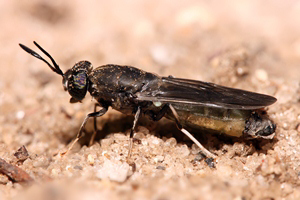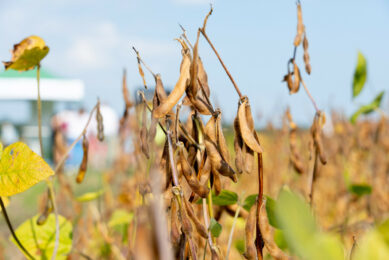Insects: The missing link in pig and poultry diets?

The use of insects as a sustainable protein rich feed ingredient in pig and poultry feed is technically feasible. Insects can therefore be an interesting link in the animal feed chain to fulfill the globally increasing demand for protein. This is the conclusion of a study done by Dutch researchers.
By Emmy Koeleman
Planet earth and its human population are struggling with increasing volumes of biowaste streams and a growing food demand by an ever increasing number of people. There is a need for innovative solutions to meet these challenges. Researchers from Wageningen University and Research Centre in the Netherlands therefore conducted a feasibility study to explore application of insects, grown on biowaste and organic by-products, as a sustainable high protein feed ingredient in pig and poultry diets, to be able to produce food of animal origin. This feasibility study comprised of a desk study and a workshop with participants representing the various links in the “insect chain”. The objective of the study was to list, in a joint initiative of industrial stakeholders and scientists, how insects can be used on a large scale as an alternative protein source in feed for pigs and poultry.
Nutritional value
The researchers identified three insects as most promising for large scale production. These are larvae of the Black soldier fly (Hermetica illucens), the Common housefly (Musca domestica), and the Yellow Mealworm (Tenebrio molitor). These insects need to be further processed in order to get insects into a form in which they are usable in the feed industry. Shelf life of insects is increased significantly by processing methods like freezing/freeze drying, however these methods are expensive. Compared to soybean meal, crude protein content of black soldier fly larvae and prepupae is lower, whereas that for mealworm and housefly is equal or higher. Fat content varies considerably among insects and can be substantial. There is a need for evaluation of nutrient digestibility of (processed) insects as feed ingredient. Potential beneficial functional properties of insect protein need to be further investigated in order to create an added value for insect protein. The Essential Amino Acid Index of the three insects in this study are above one, indicating that these protein sources provided in general more of the essential amino acids than required for broilers as well as growing pigs. For full replacement of soybean meal in fattening pig and broiler diets, large quantities (685 kiloton annually) of insects are required. Replacing 5% in compound feed for broilers means that 72 kiloton of insects a year is required.
Cost price still high
Maximum price of insects as feed ingredient for pig and poultry diets should be in the range of €1.00 – €1.50 per kg to be a competitive alternative protein source, especially to replace fishmeal. Cost price reduction is required to be able to use insects as protein source in pig and poultry diets on an economically feasible basis. Possibilities to decrease the cost price are: Increase of feed efficiency of insects and the use of cheap biowaste products, reduction of labour costs by mechanisation, automation and logistics, reduction of housing costs by increasing the size of insect rearing companies and more efficient use of buildings, reduction of energy use, heat exchange and optimal ventilation, use of high-productive protein rich insects, and decreasing processing costs. On all measures more research is recommended.
Regulation issues
Besides price, there are more barriers to overcome before insects can be introduced in pig and poultry feed. One of them is the volume available. Currently, the production volume of insects in rearing companies in the Netherlands is low and the market is mainly focused on zoos and pet shops (to feed birds, reptiles, mammals and amphibians). Although the researchers find the use of insects in pig and poultry feed promising, opinions differed on whether it would be possible to do it within five years or more. It was generally expected that the use of insects as a feed ingredient in aquaculture is the nearest future application, as well as the use in pet foods. Main obstacles were identified by the Dutch research team in the area of legislation and the achievement of a low cost price by an automation of the production process. So far, in the EU, it is not allowed to use insect protein in feed for pigs and poultry due to the TSE regulation. Further risk assessment of use of insects as feed ingredient is required
to develop new regulations. The currently used GMP+ certification for the animal feed industry should be adjusted for use of insects as feed ingredient. To introduce insects as a feed ingredient in the pig and poultry feed chain, additional research is recommended on its feeding value, inclusion levels in poultry and pig diets, functional properties of the feed ingredient, safety when using biowaste as a rearing substrate, extraction of nutrients, shelf-life, and use of left-over substrates and residue products of insects. Insects can be reared on low-grade biowaste and can turn low-grade biowaste into high quality proteins. Insects therefore can be a promising interesting link in the animal feed chain to fulfil the globally increased demand for protein. It is feasible to use insects on a large-scale as future feed material. However, opinions differed on the pace of this development: will it take less or more than five years.
Recommendations
To make use of insects as a feed ingredient in pig and poultry diets on a large scale it is important to increase the scale of insect production further with a continuous quantity and quality. It is also needed to decrease the cost price of insect rearing further in order to be competitive with currently used protein sources. The researchers also recommend that the insect chain with stakeholders is further developed. These include suppliers of organic side-streams, insect rearing companies, processing industry of insects, animal feed industry, pig and poultry producers and retail. The researchers also recommended to start a lobby on European level to accept insects as a feed ingredient for livestock. The authorities can act in a facilitating role In general, the authorities may help to facilitate the process for introduction of insects as an ingredient in pig and poultry diets.
Issued in AllAboutFeed 21.01











